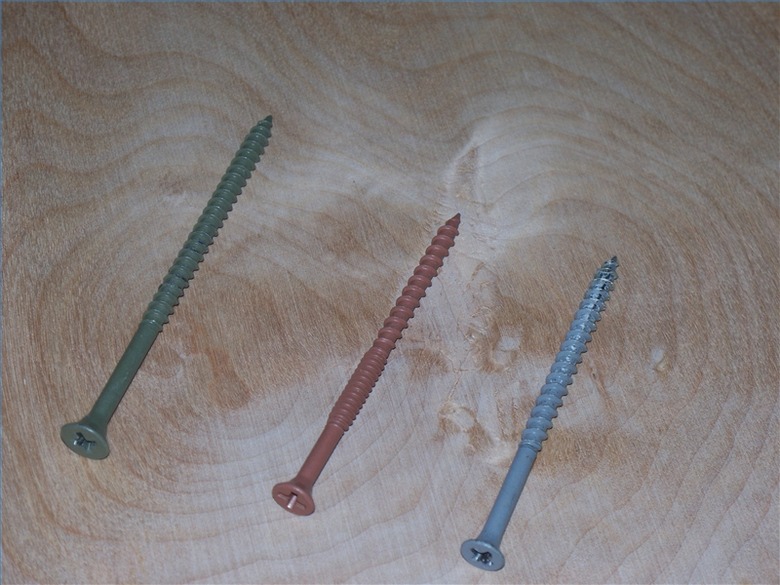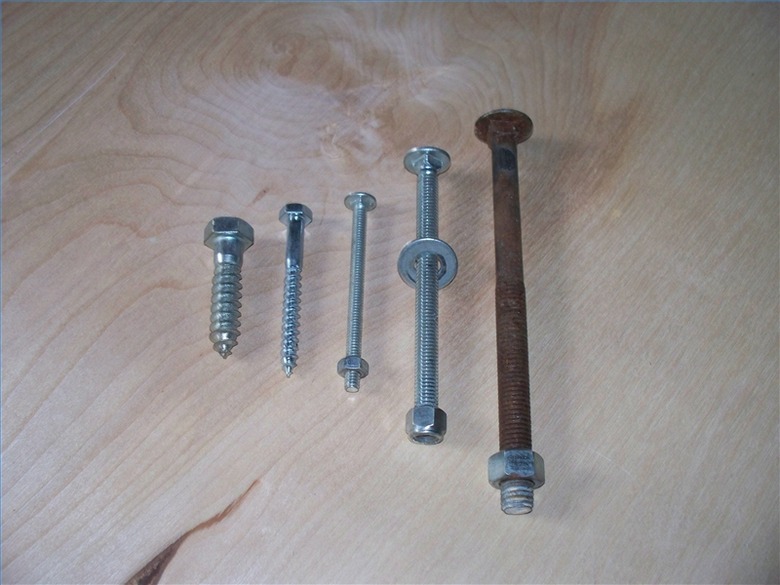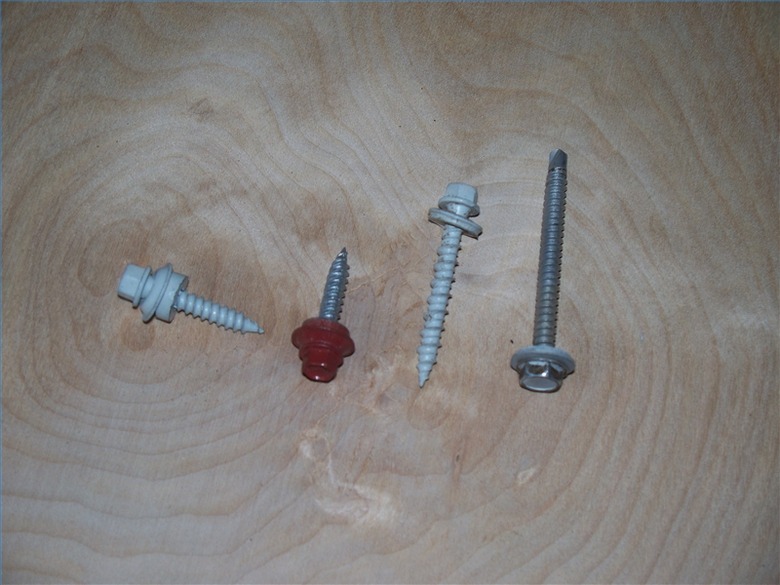The Best Type Of Screws & Bolts For Outside Use
When building any outdoor structure whether it's a deck, shed or dock, selecting the best type of fasteners is important. After selecting a building plan, choosing the right fastener might be the most critical choice the outdoor builder faces, because the fasteners keep the entire project from falling apart. The "best" fastener for the job is directly dependent upon what's being constructed as well as its geographic location.
Screws: The Choices Are Endless
Screws: The Choices Are Endless
For decks, wood fences or attaching wood siding, many builders use tapered head screws. Their choice is determined by the thickness and composition of the material to be fastened. When installing pressure treated planks, "green screws" are the best choice. They have a special coating that prevents the chemicals in the lumber from rusting them. If a deck will be planked with composite material, special screws have been designed to bore cleanly and not "mushroom" the composite material as they are tightened. If sheets of untreated siding are being installed, galvanized screws are a good choice. For a shadow fence, galvanized screws are also an excellent choice. However, the best feature about screws is that they can be removed without damaging whatever they're screwed in to.
The critical factor when using screws is that their length be sufficient to provide adequate holding power. The 3:1 rule is the best method for determining this. As an example, screws securing 1-inch deck planks should be a minimum of 3 inches in length.
Purchase the screws when you buy the other materials. Home improvement centers stock most screw types. Ask for advice in selecting the best screw for a particular job.
Lag Screws
Lag Screws
Lag screws, or lag bolts, are heavy-duty fasteners best used when attaching framing components such as posts, joists and headers. They are available in a variety of diameters and lengths and can be purchased as bright metal or galvanized. For outdoor projects, galvanized is the better choice.
Lag screws have a hex head and can be driven using a hand-held socket wrench or a drill driver equipped with a hex bit. Lag screws should be inserted into a predrilled hole bored slightly smaller in diameter than the lag screw and slightly shallower than its length. This ensures that the threads will penetrate deeply and hold tight.
If the head of the lag screw must be set flush with or slightly below the surface, use a spade bit of sufficient width to cut a recess into the material. Be sure the bit is large enough that the walls of the socket will fit inside the recess you create.
Slip a washer over the lag screw before driving it. As it socks up, the washer prevents the head from becoming "buried" in the wood and spreads the stress load to help prevent cracking. Just be sure the recess you cut with the spade bit is deep enough to accommodate the combined thickness of both the washer and the screw head.
Carriage Bolts
Carriage Bolts
Like lag screws, carriage bolts are available in a variety of lengths, diameters and coatings. When attaching wooden components together with carriage bolts, standard practice is to clamp the pieces together prior to drilling the hole for the bolt. The hole should be just slightly smaller than the bolt's diameter. Once it's drilled, use a hammer to drive the bolt through both pieces. Secure it with a washer and nut. If the framing will be difficult to reach or completely hidden when the project is finished, use a flat washer and a lock washer to ensure that the nut never loosens.
When sizing carriage bolts, the bolt must be longer than the two pieces being bolted together. So be sure to have enough of the threaded end protruding to allow for the washer and nut.
Roofing Screws
Roofing Screws
If your outdoor project is a shed or barn, it's going to need a roof. And metal roofing panels are the best choice. Metal roofing comes in a host of lengths and colors. Metal roofing is available as painted steel panels or aluminum. The type and color of roofing you choose will have a direct bearing on the type of screws you use. The most prevalent type is hex headed and can be installed using a drill driver equipped with a hex bit. The screws also come equipped with both a washer and rubber grommet. As the screws are tightened down, the washer and grommet compress to help prevent leaks.
For steel roofing, painted screws are available in several colors to match the panels. They are available in 1-inch or 2-inch lengths and can be purchased wherever metal roofing is sold. The screws must be of the same metal as the roofing. Using steel screws on aluminum roofing panels will lead to galvanic corrosion, a naturally occurring electrical charge which will eventually eat away the metal. The same thing goes for aluminum screws and steel panels.
Geographic Considerations
Geographic Considerations
If your project will be built near salt water, the fastener you use, whether screws or bolts, at minimum should be galvanized. However, even if galvanized fasteners are used, exposure to salt air or salt water will limit their lifespan. A far better, though fairly expensive, alternative is to use stainless steel fasteners. They are not generally available at most home improvement stores, so you may need to scour the web for dealers specializing in these items.


